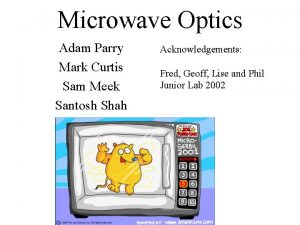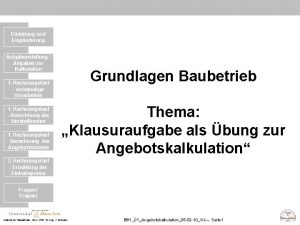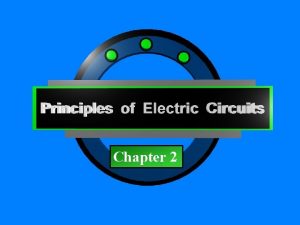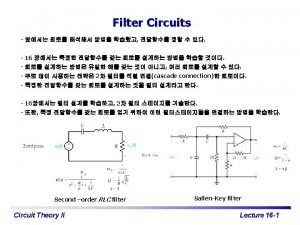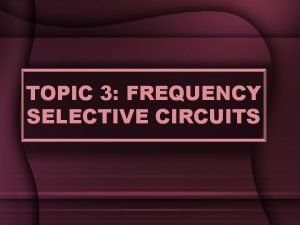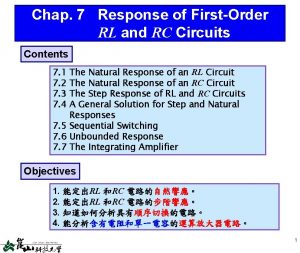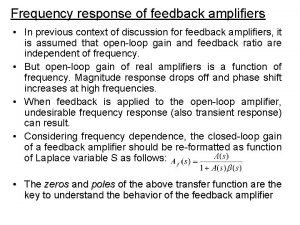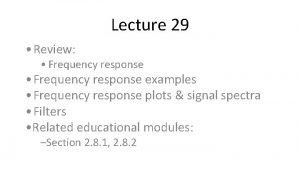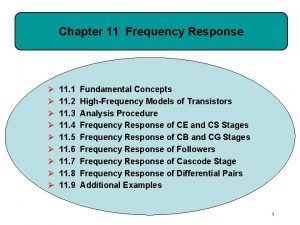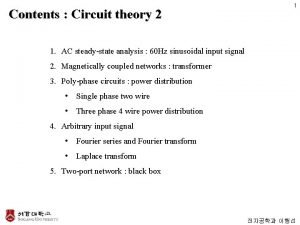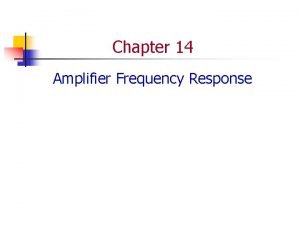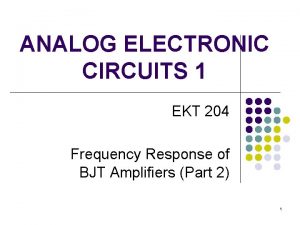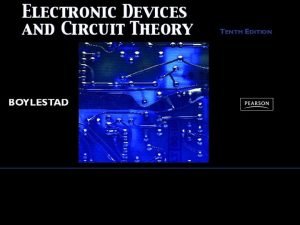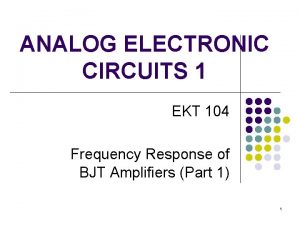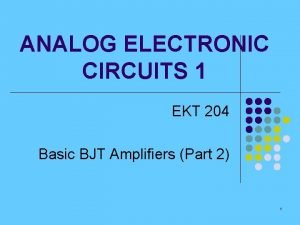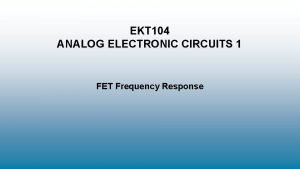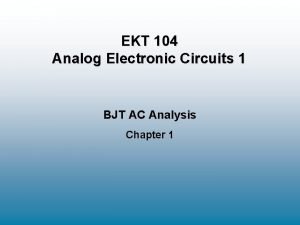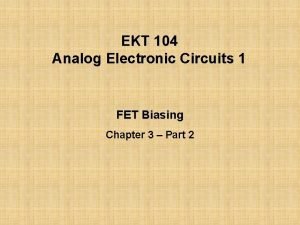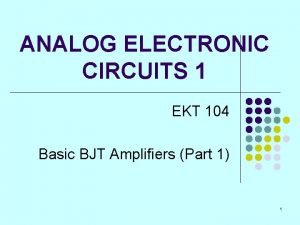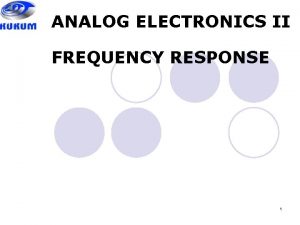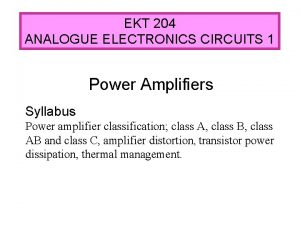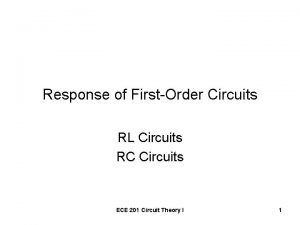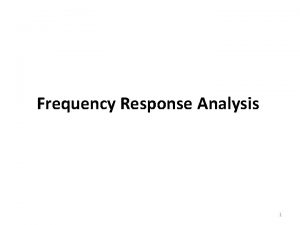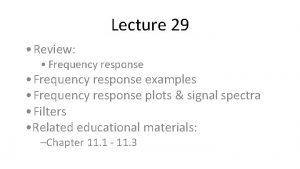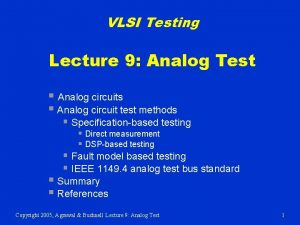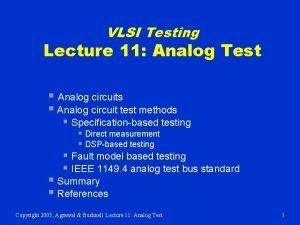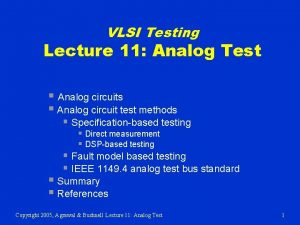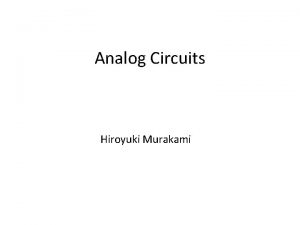ANALOG ELECTRONIC CIRCUITS 1 EKT 204 Frequency Response



























- Slides: 27

ANALOG ELECTRONIC CIRCUITS 1 EKT 204 Frequency Response of BJT Amplifiers (Part 1) 1

The Decibel (d. B) l l A logarithmic measurement of the ration of power or voltage Power gain is expressed in d. B by the formula: where ap is the actual power gain, Pout/Pin Voltage gain is expressed by: l If av is greater than 1, the d. B is +ve, and if av is less than 1, the d. B gain is –ve value & usually called attenuation 2

Amplifier gain vs frequency Midband range Gain falls of due to the effects of stray capacitance and transistor capacitance effects Gain falls of due to the effects of CC and CE 3

Definition l l l Frequency response of an amplifier is the graph of its gain versus the frequency. Cutoff frequencies : the frequencies at which the voltage gain equals 0. 707 of its maximum value. Midband : the band of frequencies between 10 f. L and 0. 1 f. H where the voltage gain is maximum. The region where coupling & bypass capacitors act as short circuits and the stray capacitance and transistor capacitance effects act as open circuits. Bandwidth : the band between upper and lower cutoff frequencies Outside the midband, the voltage gain can be determined by these equations: Below midband Above midband 4

Lower & Upper Critical frequency q q Critical frequency a. k. a the cutoff frequency The frequency at which output power drops by 3 d. B. [in real number, 0. 5 of it’s midrange value. An output voltage drop of 3 d. B represents about a 0. 707 drop from the midrange value in real number. Power is often measured in units of d. Bm. This is decibels with reference to 1 m. W of power. [0 d. Bm = 1 m. W], where; 5

Gain & frequencies l l Gain-bandwidth product : constant value of the product of the voltage gain and the bandwidth. Unity-gain frequency : the frequency at which the amplifier’s gain is 1 6

LOW FREQUENCY l l At low frequency range, the gain falloff due to coupling capacitors and bypass capacitors. As signal frequency , the reactance of the coupling capacitor, XC - no longer behave as short circuits. 7

Short-circuit time-constant method (SCTC) l To determine the lower-cutoff frequency having n coupling and bypass capacitors: Ri. S = resistance at the terminals of the ith capacitor Ci with all the other capacitors replaced by short circuits. 8

Common-emitter Amplifier VCC = 12 V Given : R 1 30 k Q-point values : 1. 73 m. A, 2. 32 V RS = 100, VA = 75 V 1 k Therefore, r = 1. 45 k , v. S RC 4. 3 k C 1 C 2 v. O 0. 1 F RL 2 F R 2 10 k 100 k RE 1. 3 k C 3 10 F ro =44. 7 k 9

Common-emitter Amplifier - Low-frequency ac equivalent circuit C 2 RS C 1 RC vs vo RB RE RL C 3 In the above circuit, there are 3 capacitors (coupling plus bypass capacitors). Hence we need to find 3 resistances at the terminals of the 3 capacitors in order to find the lower cut-off frequency of the amplifier circuit. 10

Circuit for finding R 1 S Rin. CE RS R 1 S RC RB RL Replacing C 2 and C 3 by short circuits 11

Circuit for finding R 2 S Rout. CE Replacing C 1 and C 3 by short circuits R 2 S RC RS RB RL 12

Circuit for finding R 3 S RTH Replacing C 1 and C 2 by short circuits RC||RL RS RB RE R 3 S Rout. CC 13

Estimation of L 14

Common-base Amplifier RS 100 v. S 4. 7 F 1 F v. O C 1 RE 43 k -VEE RC 22 k C 2 RL 75 k +VCC Given : Q-point values : 0. 1 m. A, 5 V Therefore, = 100, VA = 70 V r = 26 gm = 3. 85 m. S, ro = 700 k 15

Common-base Amplifier - Low-frequency ac equivalent circuit RS vs vo C 2 C 1 RE RC RL 16

Circuit for finding R 1 S RS Replacing C 2 by short circuit R 1 S RE RC || RL Rin. CB 17

Circuit for finding R 2 S Rout. CB Replacing C 1 by short circuit RS || RE RC R 2 S RL 18

Estimation of L 19

Common-collector Amplifier +VCC RS 1 k v. S C 1 0. 1 F RB 100 k C 2 100 F RE 3 k v. O RL 47 k -VEE Given : Q-point values : 1 m. A, 5 V Therefore, = 100, VA = 70 V r = 2. 6 k , ro =70 k 20

Common-collector Amplifier - Low-frequency ac equivalent circuit RS C 1 C 2 vs vo RB RE RL 21

Circuit for finding R 1 S RS R 1 S Rin. CC Replacing C 2 by short circuit RB RE || RL 22

Circuit for finding R 2 S Replacing C 1 by short circuit Rout. CC R 2 S RTH = RS || RB RE RL 23

Estimation of L 24

Example Given : Q-point values : 1. 6 m. A, 4. 86 V VCC = 10 V = 100, VA = 70 V R 1 62 k Therefore, r = 1. 62 k , ro = 43. 75 k , gm = 61. 54 m. S v. S Determine the total lowfrequency response of the amplifier. RS RC 2. 2 k C 1 C 2 0. 1 F RL 10 k 600 0. 1 F R 2 22 k v. O RE 1. 0 k C 3 10 F 25

Low frequency due to C 1 and C 2 C 3 Low frequency due to C 1 Low frequency due to C 2 26

Low frequency due to C 3 27
 Unilab
Unilab Kalkulationsberechnung
Kalkulationsberechnung Series parallel circuit current
Series parallel circuit current Principles of electric circuits
Principles of electric circuits Frequency selective circuit
Frequency selective circuit Rl circuit transfer function
Rl circuit transfer function Frequency selective circuits
Frequency selective circuits Rc response
Rc response Scrip exchange
Scrip exchange Electronic news gathering and electronic field production
Electronic news gathering and electronic field production Relative frequency bar chart
Relative frequency bar chart How to calculate relative frequency
How to calculate relative frequency Conditional frequency
Conditional frequency Average of sine wave
Average of sine wave Vmax=aw
Vmax=aw Joint frequency
Joint frequency What is a marginal frequency
What is a marginal frequency Herds nys
Herds nys Frequency response of feedback amplifier
Frequency response of feedback amplifier Frequency response of rc coupled amplifier
Frequency response of rc coupled amplifier Frequency response cbe
Frequency response cbe Frequency response
Frequency response Source follower frequency response
Source follower frequency response Circuit theory 2
Circuit theory 2 Frequency response curve of an amplifier
Frequency response curve of an amplifier Frequency response cbe
Frequency response cbe Bjt frequency response
Bjt frequency response Tanggapan frekuensi
Tanggapan frekuensi
